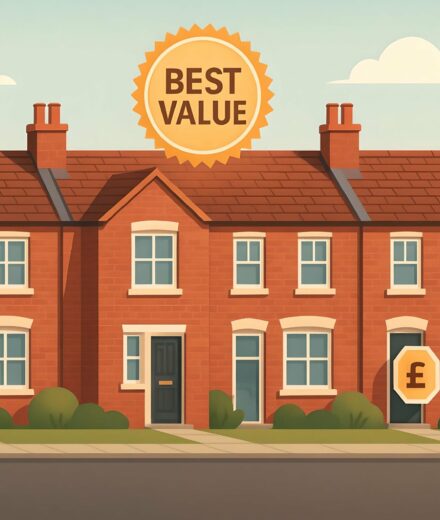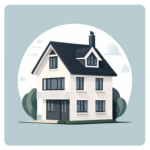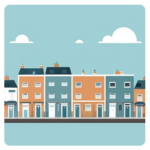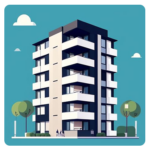

The lines on the chart aren’t steep, but they’re climbing. Bury St Edmunds’s housing figures continue to suggest something dependable, if not dazzling.
Everything’s laid out here on our House Prices in Bury St Edmunds page – values, volume, and the bits that actually tell a story.
House Prices > Bury St Edmunds
| Year | Average Price | Transactions |
|---|---|---|
| 2025 (proj.) | £341,700 | 2,165 |
| 2024 | £337,900 | 1,497 |
| 2023 | £347,900 | 2,009 |
| 2022 | £357,200 | 2,648 |
| 2021 | £332,700 | 2,966 |
| 2020 | £318,900 | 1,985 |
| 2019 | £309,300 | 1,986 |
| 2018 | £317,900 | 2,065 |
Bury St Edmunds’ property market, known for its characterful streets and enduring charm, has displayed some interesting, occasionally unpredictable, price movements since 2018. Glancing over recent years, it’s clear that property values haven’t just moved in one straight line - instead, they’ve ebbed and flowed, influenced by wider economic ripples and local circumstances.
For those thinking about their next move, the average property price in 2024 mirrors the area’s enduring popularity, even as it remains below the high-water mark of late 2022. At M0VE, we’ve spotted that well-located family homes are still snapped up quickly, especially in neighbourhoods close to the Abbey Gardens or Moreton Hall.
If you’re pondering whether the area’s dip in prices means better value, or just a pause before the next upward swing, take a look at our guide on Is Buying in Bury St Edmunds More Affordable Than Other Areas? for a wider perspective.
So what’s the core message? Bury St Edmunds’ property prices are still robust, supported by steady demand, but they are not immune to national headwinds or local quirks. If you’re eager to make your move in Suffolk, there’s no substitute for timing, a good plan, and a keen eye for value.
Checking what homes go for in Bury St Edmunds? Here's the up-to-date list of properties available to buy in Bury St Edmunds.

Avg. Property Price: £471,500
Avg. Size of Property
1,445 sq/ft
Avg. Cost Per Sq/ft
£343 sq/ft
Total transactions
1,807 (since 2021)

Avg. Property Price: £315,300
Avg. Size of Property
977 sq/ft
Avg. Cost Per Sq/ft
£333 sq/ft
Total transactions
1,048 (since 2021)

Avg. Property Price: £266,400
Avg. Size of Property
844 sq/ft
Avg. Cost Per Sq/ft
£323 sq/ft
Total transactions
1,440 (since 2021)

Avg. Property Price: £197,400
Avg. Size of Property
679 sq/ft
Avg. Cost Per Sq/ft
£293 sq/ft
Total transactions
182 (since 2021)
The property market in Bury St Edmunds continues to showcase an eclectic blend of historic charm, modern upgrades and bold price differentials across property types. If you pause and look closely, you’ll see a market where the classic English pursuit of space collides with the new reality of aspiring home ownership. Buyers face a genuine game of trade-offs between square footage, location and budget, and those choices are more pronounced now than ever.
Detached homes sit at the top of the price tree, their spacious layouts and larger plots echoing a kind of Suffolk grandeur. With their impressive square footage and high ticket price, they attract those seeking not just room to grow, but the privacy and prestige that come with a separate address. Yet, as the number of completed sales shows, they remain a vibrant segment, buoyed by families whose dreams have outgrown terraced cottage life.
Flats and apartments cut a different silhouette against the Bury sky. These homes provide a pragmatic entry point for solo buyers or those priced out of more substantial properties. The average flat is compact, yet not without appeal: central locations, low maintenance, and often, a smart modern finish. Even so, with only a handful of deals agreed since 2021, it seems most buyers yearn for a slice of garden or the extra internal space. If you’re hunting for a bargain in Bury St Edmunds, finding a truly affordable flat these days is rather like searching for a needle in a haystack – and someone’s hidden the haystack somewhere off Nowton Road.
Semi-detached and terraced homes fill the vital middle ground. Their price points reflect a delicate compromise between space and accessibility, with a healthy volume of sales suggesting ongoing, strong demand. These properties have, for decades, carried families from first newborns to empty nests – and Bury’s streets are still packed with examples, from leafy suburbia to lively corners near the Abbey. They strike an appealing balance: more affordable than detached, but offering a chunk more freedom than most flats.
Look beneath the surface at cost per square foot, and a more nuanced story emerges. Detached homes come with the highest upfront bill, yet their cost per square foot advantage is clear for those prioritising value and room to spread out. Semi-detached and terraced properties offer a solid middle ground, while flats, despite being smaller, aren’t necessarily “cheap” on a price per foot basis – a sobering consideration for those fresh to the market.
If you’re keen to gauge whether your current property fits the market trend or to get a sense of what your budget might achieve, take a deeper look at valuing your home in Bury St Edmunds.
| District | Avg Price (£) | Transactions |
|---|---|---|
| IP14 | £335,000 | 2 |
| IP28 | £287,000 | 3,556 |
| IP29 | £412,000 | 901 |
| IP30 | £373,600 | 2,135 |
| IP31 | £372,800 | 2,630 |
| IP32 | £315,800 | 2,831 |
| IP33 | £315,800 | 3,220 |
In typical Bury St Edmunds fashion, property prices across the local districts are more unpredictable than the Suffolk weather forecast. It's a patchwork of neighbourhoods where your postcode can whack thousands off (or add them) to the asking price. So, if you fancy getting the best bang for your buck, you might want to pay attention – or just cross your fingers, both can work here.
Let’s start with the outliers. Certain pockets boast prices that are positively stratospheric – think more champagne than budget brand lemonade. In IP29, for example, the eye-watering average is enough to make even seasoned estate agents wince. Clearly, demand for these leafy, charming outer zones remains rock-solid, with buyers paying a premium for a postcard-perfect setting, a bit more privacy, and perhaps the vague hope they’ll one day spot David Attenborough in their hedgerow.
Then you've got IP30 and IP31, where average figures flirt cheekily with the four hundred grand mark, and buyers seem to be queueing up like it’s the last can of Adnams in the shop. These areas are prime for those chasing a mix of rural calm and decent commute times – so no wonder transactions have reached such robust numbers.
Not that the “core” of Bury St Edmunds is missing out on action. IP32 and IP33 may have average prices that skim under their glitzier neighbours, but blink and you'll see they're the busiest bee in the hive for recorded home sales. It’s a classic mix: more accessible pricing for families and newcomers, coupled with the town's irresistible historic vibe. Frankly, you’ll need to move faster than a dog after a runaway pork pie if you want to snag something appealing here.
And let’s not forget IP28, where thousands of property transactions speak to a thriving, energetic district. The numbers alone show there's no shortage of appetite, even if the average price is a touch friendlier (well, Bury St Edmunds standards, anyway).
If sniffing out the bargain districts is your passion, there are still a few sensible options to be found, especially for the eagle-eyed buyer. The patchwork charm of Bury ensures that, whether you’re after tranquillity or want to be close to town, there’s always a corner with your name on it. For a closer look at neighbourhoods matching your budget, check out where smart buyers are snapping up affordable districts in Bury St Edmunds.
In Bury St Edmunds, property prices are sprinting up faster than a jack russell after a squirrel. Whether you’re in the market for a stately abode or something cosier, being nimble and informed isn’t just helpful – it’s critical.
Please also check out the following areas in Bury St Edmunds for further insights:
| City | Avg Price (£) | Transactions |
|---|---|---|
| Newmarket | £327,300 | 2,718 |
| Brandon | £206,400 | 1,707 |
| Stowmarket | £285,600 | 4,248 |
| Sudbury | £322,500 | 3,773 |
| Thetford | £247,600 | 4,704 |
| Haverhill | £279,300 | 2,905 |
| Diss | £322,100 | 2,296 |
| Eye | £371,600 | 918 |
| Ely | £325,200 | 5,288 |
| Attleborough | £292,600 | 2,188 |
When you set your sights on Bury St Edmunds, you’re looking at an area where house prices sit firmly in the mid-to-high range among its Suffolk and Norfolk neighbours. The vibe here is quietly prosperous – property prices aren’t galloping ahead, but they are consistently rising, in a way that feels reassuring for both owner-occupiers and speculative landlords. Think of it as a property market keeping a calm but purposeful stride, much like the steady stream of shoppers spilling out onto Abbeygate Street on a lazy Saturday afternoon.
Looking beyond Bury St Edmunds, we see the landscape shift quite dramatically:
Bury St Edmunds continues to tempt investors and families alike, not with flashy spikes, but with sturdy, incremental gains and a sense of local confidence. If you’re chasing not just a property, but a sense of enduring prosperity, this inviting market may fit just right.
Please be aware, these numbers highlight average sale prices and transactions alone.
They do not adjust for differences in property size or cost per square foot. For a closer view, head over to our blog. Thank you.
Official data gives us the framework. We refine it carefully to account for the real differences between properties, delivering intelligent, well-adjusted valuations for every location we cover. Check how the model shapes each price
Our site uses cookies. By using this site, you agree to the Privacy Policy and Terms of Use.